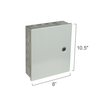Small Relay Panel, (2x) 2-Pole
Features
-
Comes with 4 poles (two 2-pole pairs)
-
Each of the 2 relays in the RLY-4PL-CC are rated for up to 30 Amps
-
Designed for use with snow melting, slab heating, and roof and gutter deicing systems
-
Safe: cULus approved and NEMA 1-rated metal enclosure
-
Limited 2-year warranty
Relay Panels Description
Featuring a NEMA 1 indoor enclosure and clearly labeled terminals to facilitate installation, the RLY-4PL-CC small relay panels are designed for use with snow melting, slab heating, and roof deicing applications. Appropriate for use with 120, 208, 240 or 277 VAC heating elements, they are virtually silent during operation. The RLY-4PL-CC panels are cULus approved and each of the 2 relays in the RLY-4PL-CC are rated for up to 30 Amps. Comes with 4 poles (two 2-pole pairs) and easy-to-use “push-in” terminals for connecting the leads and power supply.
Learn more about snow melting systems. Perfect for heated driveways, patios, walkways and paths, accessibility ramps, or even stairs.
Specifications
Electrical
| Applicable Voltages | 120 V, 208 V, 240 V, 277 V |
| Connection Method | Hardwired |
| Maximum Current | 30 A |
| Numbers of Poles | 4 |
Warranty / Certifications
| Approvals | cULus listed |
| Warranty | 2 years |
| Waterproofing | NEMA 1 |
Product Dimensions
| Depth | 4″ |
| Height | 10.5″ |
| Weight | 7.4 lbs |
| Width | 8″ |
Identifiers
| SKU | RLY-4PL-CC |
| UPC (GTIN-12) | 881308065379 |
Documents
Technical Information
Wiring Diagrams
Frequently Asked Questions
The material costs are similar. However, electric systems are easier to install, with fewer components and significantly lower maintenance costs. Electric systems will run for a shorter period of time to give the same level of performance but with much higher energy efficiency (typically 95%-98% efficient). Controls and sensors required for the two types of systems are very similar. Electric systems do not usually require slab insulation and do not create the concerns typically associated with hydronic systems. These concerns include, but are not limited to, return temperatures, flue gas venting, waterway shrinkage and property damage caused by leaking pipes or tubes.
When installing outdoor WarmlyYours snow melting cables for your driveway, patio, walkway, terrace, stairs, ramp, etc. - NEVER cross, overlap, or allow the heating cables to touch each other. Doing so will quickly cause a circuit failure due to excessive heat build up. Always follow the installation instructions and/or design layout plan to ensure the cable is installed with the correct spacing required for proper operation.
Our systems can handle low temperatures, but many controls come equipped with a Low-Temperature Lockout Feature. This feature prevents the system from running in very low temperatures. At very low temperatures it can become difficult for the system to effectively melt the snow. It is however possible to turn off this feature should you need the system to keep running during such low temperatures.








